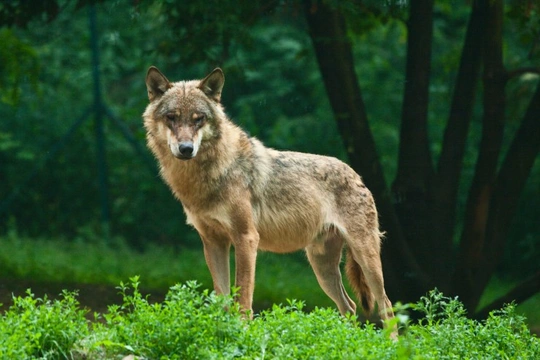
What do wolves and dogs have in common?
Most dog owners have at least a basic understanding of the historical relationship between wolves and dogs, and that dogs originated from wolves – but for many dog owners, that is as far as their understanding goes.
Our modern pet dogs are thought to have been the very first animal species that we domesticated, and this happened for the first time millennia ago, since which time humans have directed the evolution of the domestic dog through taming, selective breeding, and training. The species of dog that we keep today – Canis lupus familiaris – is very far removed from it wolf origins, with perhaps less in common with them than a lot of people think. However, there are still a number of very wolf-like traits within domestic dogs, although most of these have been softened and muted to a great degree.
If you are wondering what dogs and wolves still have in common and what wolf-like traits your own dog possesses, read on to find out more.
Wolves, dogs, and their genetic lineage
Ask most modern dog owners where dogs came from, and most people will be able to tell you that dogs descended from wolves. This is largely true, but there is a little more to it!
Wolves come in various different species of their own, not all of which are extant today – and it is the grey wolf that is the domestic dog’s closest modern relative. However, dogs are not descended from grey wolves, but instead, modern research has identified that the domestic dog and the grey wolf actually evolved side by side but separately, with their common ancestor being lost back in the mists of time – and so the grey wolf is more of a sister species to the domestic dog than its ancestor.
DNA correlations
The grey wolf and the domestic dog shares 98-99% of the same DNA. Whilst this is of course a huge amount, that 1-2% difference encompasses a huge range of both physical and behavioural traits, making wolves and dogs close relatives but very distinct from each other.
For context, dogs and humans also have a lot in common at the DNA level – we share around 84% of the same DNA as a dog, which puts in perspective somewhat how much DNA can be shared across two seemingly vastly different species, and makes the high level of shared DNA between wolves and dogs more contextual.
Physical appearance
Some dogs breeds undeniably look a lot more wolf-like than others – such as the Siberian husky and the German shepherd. However, when you look at other breeds like the pug or the Chihuahua, it can be really hard to see any similarities!
Understanding how different dog breeds evolved and were created helps to explain the disconnect when you really begin to appreciate how much responsibility humans have for the modern appearance of different dog breeds.
Going back to the example of the pug we mentioned earlier, their small sizes, flattened faces and other physical traits have been achieved by selective breeding, and do not reflect the way in which such breeds would have evolved on their own, left to their own devices. Dogs that have evolved with less human interference and that have a more natural appearance (or that have deliberately been bred for similar appearance traits to wolves) tend to be more similar in shape, size and build to wolves, with long tails, pointed ears, long muzzles, and a balanced, workmanlike appearance.
Temperament and behaviour
Evolutionary traits and advantages continue to influence the behaviour of our pet dogs, and many of the everyday behaviours that we see them display are also present in wolves, and the ancestors of today’s dogs.
The social nature of dogs and their participation in cooperative packs harks back to their wild wolf origins, as does things like a tendency to bury resources, eat whenever food is available, and display a naturally high prey drive.
Canine vocalisations and how dogs communicate with each other vocally is something else common to wolves, with whines, yips, growls and howling all shared across both species.
Additionally, both wolves and dogs are hunter-scavengers, and care for and raise their own young whilst teaching them the skills they need to thrive on their own. Wild wolves also tend to mate at times of year that mean their offspring will be born in the spring or summer when resources like food are easier to come by, and whilst planned dog matings negate this effect, left to their own devices, dogs follow the same seasonal patterns.
Dogs and wolves will often fight acutely – even to the death, in some cases – over a bitch in heat, and tend to roam across large distances in the wild to find a mate.
How similar are dogs and wolves?
There are a huge range of temperament traits shared between dogs and wolves, but there are also a large number of differences. Wolves, even when cubs, cannot be trained to follow commands and exhibit loyalty to the same high degree a dog can, and wolves retain an independent streak and tendency to roam where possible, even when they are used to humans.
You will probably see small clues to your dog’s wolf origins in their behaviour every day if you know what to look for – but also, just as many differences that make domestic dogs unique – and that explain why wolves aren’t kept on a large scale as pets!



